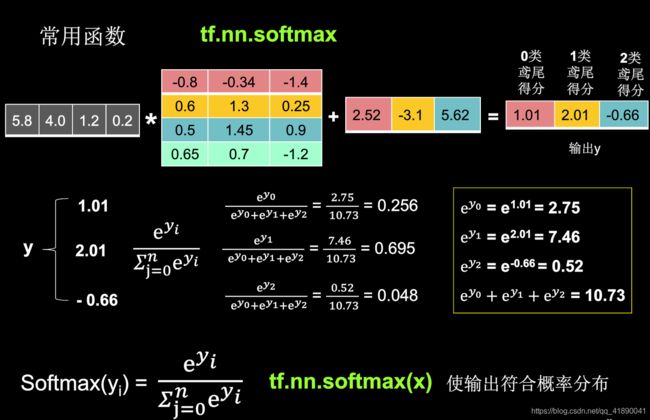MOOC人工智能实践:Tensorflow笔记1.4 1.5
- 1.4TF2常用函数1
-
- tf.cast
- tf.reduce_min tf.reduce_max
- tf.reduce_mean tf.reduce_sum
- tf.Variable
- Tensorflow中的数学运算
- 1.5TF2常用函数2
-
- tf.data.Dataset.from_tensor_slices
- tf.GradientTape
- enumerate
- tf.one_hot
- tf.nn.softmax
- tf.assign_sub
- tf.argmax
1.4TF2常用函数1
tf.cast
tf.reduce_min tf.reduce_max
·强制tensor转换为该数据类型
tf.cast(张量名,dtype=数据类型)
·计算张量维度上元素的最小值
tf.reduce_min(张量名)
·计算张量维度上元素的最大值
tf.reduce_max(张量名)
import tensorflow as tf
x1 = tf.constant([1., 2., 3.], dtype=tf.float64)
print("x1:", x1)
x2 = tf.cast(x1, tf.int32)
print("x2", x2)
print("minimum of x2:", tf.reduce_min(x2))
print("maxmum of x2:", tf.reduce_max(x2))
运行结果:
x1: tf.Tensor([1. 2. 3.], shape=(3,), dtype=float64)
x2 tf.Tensor([1 2 3], shape=(3,), dtype=int32)
minimum of x2: tf.Tensor(1, shape=(), dtype=int32)
maxmum of x2: tf.Tensor(3, shape=(), dtype=int32)
tf.reduce_mean tf.reduce_sum
·计算张量沿着指定维度的平均值
tf.reduce_mean(张量名,axis = 操作值)
·计算张量沿着指定维度的和
tf.reduce_sum(张量名,axis = 操作值)
注意:axis=0纵向操作,axis=1横向操作
import tensorflow as tf
x = tf.constant([[1, 2, 3], [2, 2, 3]])
print("x:", x)
print("mean of x:", tf.reduce_mean(x))
print("sum of x:", tf.reduce_sum(x, axis=1))
运行结果:
x: tf.Tensor(
[[1 2 3]
[2 2 3]], shape=(2, 3), dtype=int32)
mean of x: tf.Tensor(2, shape=(), dtype=int32)
sum of x: tf.Tensor([6 7], shape=(2,), dtype=int32)
tf.Variable
·tf.Variable()变量标记为“可训练”。神经网络训练中,常用该函数标记待训练参数
tf.Variable(初始值)
w = tf.Variable(tf.random.normal([2,2], mean=0, stddev=1))
Tensorflow中的数学运算
·对应元素的四则运算
tf.add, tf.subtract, tf.multiply, tf.divide
·平方、次方与开方
tf.square, tf.pow, tf.sqrt
·矩阵乘
tf.matmul
注意:只有维度相同的元素才可以进行四则远算
import tensorflow as tf
a = tf.ones([1, 3])
b = tf.fill([1, 3], 3.)
print("a:", a)
print("b:", b)
print("a+b:", tf.add(a, b))
print("a-b:", tf.subtract(a, b))
print("a*b:", tf.multiply(a, b))
print("b/a:", tf.divide(b, a))
运行结果:
a: tf.Tensor([[1. 1. 1.]], shape=(1, 3), dtype=float32)
b: tf.Tensor([[3. 3. 3.]], shape=(1, 3), dtype=float32)
a+b: tf.Tensor([[4. 4. 4.]], shape=(1, 3), dtype=float32)
a-b: tf.Tensor([[-2. -2. -2.]], shape=(1, 3), dtype=float32)
a*b: tf.Tensor([[3. 3. 3.]], shape=(1, 3), dtype=float32)
b/a: tf.Tensor([[3. 3. 3.]], shape=(1, 3), dtype=float32)
----------------------------------------------------
a = tf.fill([1, 2], 3.)
print("a:", a)
print("a的平方:", tf.pow(a, 3))
print("a的平方:", tf.square(a))
print("a的开方:", tf.sqrt(a))
运行结果:
a: tf.Tensor([[3. 3.]], shape=(1, 2), dtype=float32)
a的平方: tf.Tensor([[27. 27.]], shape=(1, 2), dtype=float32)
a的平方: tf.Tensor([[9. 9.]], shape=(1, 2), dtype=float32)
a的开方: tf.Tensor([[1.7320508 1.7320508]], shape=(1, 2), dtype=float32)
----------------------------------------------------
a = tf.ones([3, 2])
b = tf.fill([2, 3], 3.)
print("a:", a)
print("b:", b)
print("a*b:", tf.matmul(a, b))
运行结果:
a: tf.Tensor(
[[1. 1.]
[1. 1.]
[1. 1.]], shape=(3, 2), dtype=float32)
b: tf.Tensor(
[[3. 3. 3.]
[3. 3. 3.]], shape=(2, 3), dtype=float32)
a*b: tf.Tensor(
[[6. 6. 6.]
[6. 6. 6.]
[6. 6. 6.]], shape=(3, 3), dtype=float32)
1.5TF2常用函数2
tf.data.Dataset.from_tensor_slices
·生成输入特征/标签对,构建数据集
data = tf.data.Dataset.from_tensor_slices((特征, 标签))
import tensorflow as tf
features = tf.constant([12, 23, 10, 17])
labels = tf.constant([0, 1, 1, 0])
dataset = tf.data.Dataset.from_tensor_slices((features, labels))
for element in dataset:
print(element)
运行结果:
(<tf.Tensor: id=9, shape=(), dtype=int32, numpy=12>, <tf.Tensor: id=10, shape=(), dtype=int32, numpy=0>)
(<tf.Tensor: id=11, shape=(), dtype=int32, numpy=23>, <tf.Tensor: id=12, shape=(), dtype=int32, numpy=1>)
(<tf.Tensor: id=13, shape=(), dtype=int32, numpy=10>, <tf.Tensor: id=14, shape=(), dtype=int32, numpy=1>)
(<tf.Tensor: id=15, shape=(), dtype=int32, numpy=17>, <tf.Tensor: id=16, shape=(), dtype=int32, numpy=0>)
tf.GradientTape
·with结构记录计算过程,gradient求出张量的梯度
with tf.GradientTape() as tape:
若干个计算过程
grad = tape.gradient(函数,对谁求导)
import tensorflow as tf
with tf.GradientTape() as tape:
x = tf.Variable(tf.constant(3.0))
y = tf.pow(x, 2)
grad = tape.gradient(y, x)
print(grad)
运行结果:
tf.Tensor(6.0, shape=(), dtype=float32)
enumerate
·它可遍历每个元素(如列表、元组或字符串),组合为:索引 元素,常在for循环中使用
enumerate(列表名)
seq = ['one', 'two', 'three']
for i, element in enumerate(seq):
print(i, element)
运行结果:
0 one
1 two
2 three
tf.one_hot
·tf.one_hot()函数将待转换数据,转换为one-hot形式的数据输出。在分类问题中,常用独热码做标签
tf.one_hot(待转换数据,depth=几分类)
import tensorflow as tf
classes = 3
labels = tf.constant([1, 0, 2])
output = tf.one_hot(labels, depth=classes)
print("result of labels1:", output)
print("\n")
运行结果:
result of labels1: tf.Tensor(
[[0. 1. 0.]
[1. 0. 0.]
[0. 0. 1.]], shape=(3, 3), dtype=float32)
tf.nn.softmax
·当n分类的n个输出(y0, y1, ..., yn-1)通过softmax()函数,便符合概率分布了

import tensorflow as tf
x1 = tf.constant([[5.8, 4.0, 1.2, 0.2]])
w1 = tf.constant([[-0.8, -0.34, -1.4],
[0.6, 1.3, 0.25],
[0.5, 1.45, 0.9],
[0.65, 0.7, -1.2]])
b1 = tf.constant([2.52, -3.1, 5.62])
y = tf.matmul(x1, w1) + b1
print("x1.shape:", x1.shape)
print("w1.shape:", w1.shape)
print("b1.shape:", b1.shape)
print("y.shape:", y.shape)
print("y:", y)
y_dim = tf.squeeze(y)
y_pro = tf.nn.softmax(y_dim)
print("y_dim:", y_dim)
print("y_pro:", y_pro)
运行结果:
x1.shape: (1, 4)
w1.shape: (4, 3)
b1.shape: (3,)
y.shape: (1, 3)
y: tf.Tensor([[ 1.0099998 2.008 -0.65999985]], shape=(1, 3), dtype=float32)
y_dim: tf.Tensor([ 1.0099998 2.008 -0.65999985], shape=(3,), dtype=float32)
y_pro: tf.Tensor([0.2563381 0.69540703 0.04825491], shape=(3,), dtype=float32)
tf.assign_sub
·更新参数w和b(调用之前,先用tf.Variable定义变量w,b为可训练)
w.assign_sub(w要自减的内容)
tf.argmax
·返回张量沿指定维度最大值的索引
tf.argmax(张量名,axis=操作轴)
import numpy as np
import tensorflow as tf
test = np.array([[1, 2, 3], [2, 3, 4], [5, 4, 3], [8, 7, 2]])
print("test:\n", test)
print("每一列的最大值的索引:", tf.argmax(test, axis=0))
print("每一行的最大值的索引", tf.argmax(test, axis=1))
运行结果:
每一列的最大值的索引: tf.Tensor([3 3 1], shape=(3,), dtype=int64)
每一行的最大值的索引 tf.Tensor([2 2 0 0], shape=(4,), dtype=int64)
